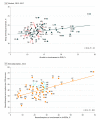Alcohol or Benzodiazepine Co-involvement With Opioid Overdose Deaths in the United States, 1999-2017
- PMID: 32271389
- PMCID: PMC7146101
- DOI: 10.1001/jamanetworkopen.2020.2361
Alcohol or Benzodiazepine Co-involvement With Opioid Overdose Deaths in the United States, 1999-2017
Abstract
Importance: The use of benzodiazepines or alcohol together with opioids increases overdose risk, but characterization of co-involvement by predominant opioid subtype is incomplete to date. Understanding the use of respiratory depressants in opioid overdose deaths (OODs) is important for prevention efforts and policy making.
Objective: To assess the prevalence and number of alcohol- or benzodiazepine-involved OODs by opioid subtypes in the United States from 1999 to 2017.
Design and setting: This repeated cross-sectional analysis used data from the Centers for Disease Control and Prevention Wide-Ranging Online Data for Epidemiologic Research (WONDER) database of all opioid-involved poisoning deaths from January 1, 1999, to December 31, 2017, for the United States. State-level binge drinking prevalence rates for 2015 to 2017 were obtained from the Behavior Risk Factor Surveillance System of the Centers for Disease Control and Prevention, and benzodiazepine prescribing rates for 2012 (most recent available data) were obtained from IMS Health, a commercial database. Data were analyzed from July 10, 2018, to May 16, 2019.
Main outcomes and measures: Prevalence of alcohol or benzodiazepine co-involvement for all OODs and by opioid subtype, nationally and by state.
Results: From 1999 to 2017, 399 230 poisoning deaths involved opioids, of which 263 601 (66.0%) were male, and 204 560 (51.2%) were aged 35 to 54 years. Alcohol co-involvement for all opioid overdose deaths increased nonlinearly from 12.4% in 1999 to 14.7% in 2017. By opioid subtype, deaths involving heroin and synthetic opioids (eg, fentanyl; excluding methadone) had the highest alcohol co-involvement at 15.5% and 14.9%, respectively, in 2017. Benzodiazepine co-involvement in all OODs increased nonlinearly from 8.7% in 1999 to 21.0% in 2017. Benzodiazepines were present in 33.1% of prescription OODs and 17.1% of synthetic OODs in 2017. State-level rates of binge drinking were significantly correlated with alcohol co-involvement in all OODs (r = 0.34; P = .02). State benzodiazepine prescribing rates were significantly correlated with benzodiazepine co-involvement in all OODs (r = 0.57; P < .001).
Conclusions and relevance: This study found that alcohol and benzodiazepine co-involvement in opioid-involved overdose deaths was common, varied by opioid subtype, and was associated with state-level binge drinking and benzodiazepine prescribing rates. These results may inform state policy initiatives in harm reduction and overdose prevention efforts.
Conflict of interest statement
Figures




References
-
- Xu JQ, Murphy SL, Kochanek KD, Bastian B, Arias E. Deaths: final data for 2016. Natil Vital Stat Rep. 2018;67(5):1-76. - PubMed
MeSH terms
Substances
LinkOut - more resources
Full Text Sources
Medical

